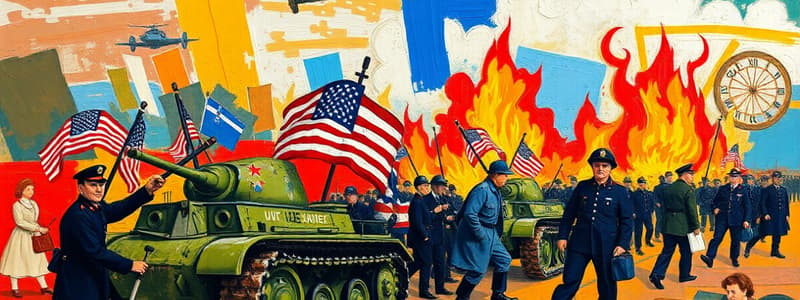Podcast
Questions and Answers
What event is commonly recognized as the catalyst for the United States entering World War II?
What event is commonly recognized as the catalyst for the United States entering World War II?
- The sinking of the Lusitania
- The Battle of the Bulge
- The attack on Pearl Harbor (correct)
- The Battle of Britain
Which geographical factor negatively impacted Germany during World War II?
Which geographical factor negatively impacted Germany during World War II?
- Having several rivers for supply routes
- Being surrounded by mountains
- Proximity to friendly nations
- Engaging on three fronts simultaneously (correct)
The ‘four freedoms’ speech advocated for increasing support for which of the following?
The ‘four freedoms’ speech advocated for increasing support for which of the following?
- Entering a peace treaty
- Increasing aid to the Allies (correct)
- Waging war against Japan
- Decreasing immigration
Who was the leader of Germany throughout most of World War II?
Who was the leader of Germany throughout most of World War II?
What is the term used for the systematic extermination of 6 million people during WWII?
What is the term used for the systematic extermination of 6 million people during WWII?
Who was the vice president during most of World War II?
Who was the vice president during most of World War II?
Which movement opposed the entry of the United States into World War II?
Which movement opposed the entry of the United States into World War II?
Which of the following is NOT a WWII battle in which the American military participated?
Which of the following is NOT a WWII battle in which the American military participated?
Of the 127,000 Japanese-Americans interned in camps during World War II, which group made up the majority?
Of the 127,000 Japanese-Americans interned in camps during World War II, which group made up the majority?
Which of these fashions became popular in the United States during World War II as a way to conserve materials?
Which of these fashions became popular in the United States during World War II as a way to conserve materials?
What significant event is referred to as 'the day which will live in infamy'?
What significant event is referred to as 'the day which will live in infamy'?
What was a common reason for the internment of Japanese-Americans during World War II?
What was a common reason for the internment of Japanese-Americans during World War II?
Which of the following was NOT a consequence of World War II on American society?
Which of the following was NOT a consequence of World War II on American society?
Flashcards
WWII VP
WWII VP
Henry Wallace served as Vice President during most of World War II.
WWII Opposition
WWII Opposition
Isolationism opposed US entry into World War II.
Non-US WWII Battle
Non-US WWII Battle
The Battle of Britain was not a battle in which the American military participated in WWII.
Japanese-American Internment
Japanese-American Internment
Signup and view all the flashcards
WWII Fashion Change
WWII Fashion Change
Signup and view all the flashcards
December 7, 1941
December 7, 1941
Signup and view all the flashcards
Who was a US VP during WWII?
Who was a US VP during WWII?
Signup and view all the flashcards
Which group opposed US entry into WWII?
Which group opposed US entry into WWII?
Signup and view all the flashcards
Pearl Harbor Attack
Pearl Harbor Attack
Signup and view all the flashcards
Three-Front War
Three-Front War
Signup and view all the flashcards
Four Freedoms Speech
Four Freedoms Speech
Signup and view all the flashcards
Adolf Hitler
Adolf Hitler
Signup and view all the flashcards
The Holocaust
The Holocaust
Signup and view all the flashcards
Study Notes
US History Unit 7 - November 2022
-
World War II Vice President: General Eisenhower was not the Vice President during most of World War II. Franklin D. Roosevelt was.
-
US Opposition to WWII Entry: Isolationism was a movement that opposed the entry of the United States into World War II.
-
WWII Battles: The Battle of Britain was not a battle that the American military participated in during World War II.
-
Japanese-American Internment: The majority of the 127,000 Japanese-Americans interned in camps during World War II were second-generation citizens.
-
WWII Fashion Conservation: Mini-skirts were not a fashion popular in the United States during World War II to conserve materials.
-
"Day of Infamy": December 7, 1941, is remembered as the day of infamy due to the attack on Pearl Harbor.
-
German WWII Defeat Contributing Factors: Germany's defeat in World War II was partly due to fighting a war on three fronts (North Africa, Western Europe, and Eastern Europe/Soviet Union).
-
German Supply Issues: Limited river access hindered German supply efforts.
-
WWII US Support for Allies: The "four freedoms" speech helped increase support for increased aid to the Allies in the United States.
-
Nazi Germany Leader: Adolf Hitler led Nazi Germany from 1933-1945.
-
Holocaust Definition: The systematic killing of approximately 6 million people (mostly Jewish) in Nazi-occupied territories during WWII is called the Holocaust.
Studying That Suits You
Use AI to generate personalized quizzes and flashcards to suit your learning preferences.




